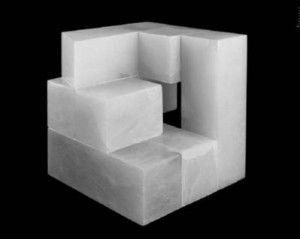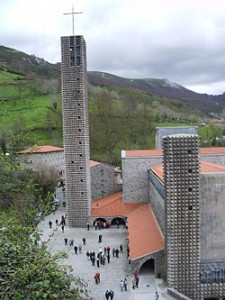

Many leaders of the contemporary art scene in the Basque country came to University of Reno, Nevada, last week to speak at the Center for Basque Studies in a symposium called “Beyond Guernica and Bilbao Relations Between Art and Politics from A Comparative Perspective.”
Artists, curators, critics, theorists talked about their work, the institutions that they lead, the exhibitions they have curated, and the relationships between art and politics in that area. It is hugely complex.
Of course the point of departure was Guernica painted by Pablo Picasso in 1937. This iconic painting of the bombing of civilians in the sacred Basque city of Gernica holds a perhaps unique position in that it is highly regarded by art historians and art critics as well as by political activists and the masses, a perspective presented at the conference by French sociologist Nathalie Heinich.
This painting was offered to the Basque government by Picasso, but they refused it at that time. Now they want it back above all else. It is currently in the Reina Sofia Museum in Madrid, after about 35 years in the Museum of Modern Art in New York City, following its display in New York City under the auspices of the American Artists Congress in 1939. The Congress was a leftist Popular Front group of artists who worked together on highly political exhibitions in New York City mainly in the late 1930s. For more information on that see my book, Art and Politics in the 1930s.
The fascinating fact about the Basque country with respect to Bilbao, the other focal point of the conference, is that this area of Spain has maintained its own independent treasury since the Middle Ages. Bilbao was an aging industrial city when Thomas Krens approached them about building a Guggenheim franchise there. Ever other European country that he had approached had turned him down, with good reason. They were supposed to pay for it. The Basque government accepted Krens’s offer. They did so with no consultation with local cultural actors, and particularly no consultation with the long time advocate and promoter of a contemporary art space for Bilbao, Jorge Oteiza (1908-2003).
Oteiza’s story is fascinating. As a sculptor he explored new ideas about space and form in both his work and his writing. His theoretical articles follow directly on the early utopian ideas of the Russian avant-garde and predate the late modernist writings of Donald Judd. They are exactly at the point of intersectionof those two perspectives. In his writings he analyzes the pre-Columbian sculpture of the Andes, the work and ideas of El Greco, Velasquez, Goya, and Popova, Malevich, Anton Pevsner, Henry Moore, and the theater spaces of Bertolt Brecht as well as the Neolithic circular Basque cromlechs and the medieval funerary stele of the Basque country, and much more.
He makes surprising characterizations of modern art in contrast to the cromlechs: “Every work of art is either an activity of forms occupying a space, or it is space that has been emptied, disoccupied. In every formal occupation, the space in conjunction with the time of reality produces the expressive tendency . . “ (324 Oteiza’s Selected Writings)

At the same time, he pioneered a minimalist aesthetic in sculpture that won the grand prize in sculpture at the Sao Paolo biennale in 1957. His minimalist forms were geometric but open, they explore stillness, immobility, and empty space.
Then, dramatically, he gave up making sculpture. As Joseba Zulaika, Director of the Center for Basque Studies, explain in the introduction to his invaluable Oteiza’s Selected Writings “Oteiza did, however, stage a second career for himself, as ambitious, conspiratorial, and influential as the first one, but now as a writer, urbanist, architect, and cultural agitator. ‘I moved from sculpture to the city.’ He would declare. “ ( 41)
Zulaika explains that it was Oteiza “the unknown artist whose visions and furies made possible the resistance to and acceptance of the Guggenheim Bilbao Museum.”
The interpretations on Oteiza as the most innovative thinker of modern Basque art history and modern theory are still multiplying. One speaker, Juan Arana, spoke of him as practicing “revolutionary artistic sacrifice” in contrast to the Bilbao which was “totalitarian artistic entertainment,” a thesis that was argued by several members of the audience.
Prominent artist and critic Txomin Badiola gave an articulate overview of the 1980s in Bilbao, particularly the New Basque Sculpture, of which he was a member as a young artist. Their action “mimicking the forms of violence” in removing Oteiza’s Homage to Malevich from the Bilbao Museum of Fine Arts and giving it to the town of Bilbao was rendered irrelevant as these young artists were confronted by the very real violence from 1984 by the ETA (Euskadi Ta Askatasuna Basque Homeland and Freedom) separatist movement. Txomin describes walking through burning barricades, surrounded by violence between police and workers.
The New Basque Sculpture only lasted for four years, but the workshop of Arteleku provided a focal point for intense exchange of discussion. It continues to the present.

Aranzuzu
Another perspective on the topic of the conference was provided by Adelina Moya and Jesus Arpal, an art historian and a professor of Philosophy and Sociology, who contrasted Aranzazu with the Bilbao as centers for Basque culture. Aranzazu is a Jesuit Sanctuary which during the years of 1950s and 1960s provided major commissions for contemporary artists, architects and painters in the midst of the reactionary and oppressive environment of both Franco’s Spain and the reactionary Catholic Church. Some of the sculpture was censored.
But this center and the artists who worked there led in the 1960s to a new awareness of Basque art and its roots and stimulated many major artists including Chillida.
The talk contrasted this organic patronage to the implanting of the Guggenheim Bilbao in the Basque country, but subsequently the Guggenheim did begin a program of exhibiting Basque art that continues to the present day.
Yet another perspective on Basque culture was offered by Zoe Bray who discussed an art center in French Basque country called Haize Berri, (“new wind”) in the village of Izura in the Pays Basque of Southern France. This small grass roots cultural center lasted for an amazing thirty years until 2009.
There were two speakers on Feminism, the artist Azucena Vietes, founder of a feminist art group called Erreakzioa-Reaccion in 1994.
She is a conceptual artist who recently held an exhibition at the Reina Sofia in Madrid. Azucena creates activist, feminist, queer projects, as well as workshops with children.
Erreakzioa- Reaccion has published magazines, zines, videos, and other records of the work of feminist artists both in Spain and in a feminist network that reaches internationally.
Zabier Arakistain (Arakis) spoke of Montehermoso a feminist institution that he helped to organize from 2008 – 2011. He identified himself as a feminist curator and art critic. This center showed the work of women artists, with a focus on feminist ideological development. It was the center of lively intellectual debates.
Aimar Arriola, a young curator and researcher, spoke of Pepe Espaliu, an avant garde artist who participated in various collective activities in the 1990s, and who died of AIDS in 1993. Arriola is rethinking the usual framing of his identity as the public face of AIDS through his work in the recently available artists’ archives.
This small area of Europe has an astonishingly compelling and unique history. Its cultural vitality reaches back centuries and continues to the present day. The language of the Basque country, called Euskara, is the last remaining language of pre Indo European languages. Its origins have never been known. The Basque area remains a rich cultural area, stimulated by the Bilbao Guggenheim, as well as the many cultural communities. Badiola emphasized that the sense of community continues to the present day.